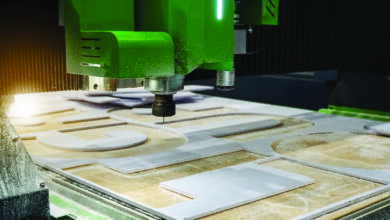
Foam board not only presents a lightweight yet rigid, durable surface for short-term indoor uses—though some of the products can last a decade—it’s quick and simple to use. Sign shops can present it as a less expensive option for signage without a heavy equipment investment.
“The main benefit of using foam board is it’s a fairly inexpensive way to display a graphic message. Foam boards are light in weight, so if any shipment is involved, freight costs are kept to a minimum,” says Lee Coda, president of Coda Inc.
Foam board, a popular substrate for retail signage, is one of the most common substrates for flatbed printing, but sign shops can use other printers to print to vinyl by attaching the vinyl to foam board for similar results.
“Foam substrates offer the benefit of having a solid form that is an extremely lightweight, durable, and cost-effective medium for producing signage. Foam core sheets are easy to manipulate and cut and are available in a variety of facer materials and finishes,” says Wade Sisco, marketing director of United Industries UltraBoard. “The life or duration of the type of installation, as well as the ambient environment, should be considered when selecting your foam board type for projects.”
For the best results
To get the best printing results, print shops should select a foam board with consistent quality and a white point that will work for most of their projects, Sisco says.
“Software tools are key for optimizing usage of materials, as it allows users to gang or group multiple projects together by automatically placing and rotating images for optimum usage of square feet,” Sisco adds. “You can utilize the surface in the most optimal way. The computer figures out the rotations to maximize the usage of the surface on the board.”
Other considerations for selecting a foam board include the desired qualities of the signage to be on display, such as density, thickness, overall size, weight, and tendency to warp, plus things like final application, length of time to be installed, location of installation and any archival needs. Coda also emphasizes the importance of giving careful consideration to the transport of the foam boards.
“At Coda, we use double-walled boxes, as well as corner and side protection,” Coda says, adding that boards larger than 30″ X 40″ should be boxed, palletized, and shipped freight for safe, damage-free transport.
The boards should also be stored lying flat to keep them from bowing against their own weight, nor should they be moved between areas with variations in temperature and humidity when laminating or printing.
“Our boards are ready to print on out of the box. The main issue we see is the handling of the materials from the carton to the printer,” Sisco says, adding that the right type of gloves will avoid contamination and smudging or fingerprints.
Humidity and moisture both affect foam boards, and the boards should be stored in temperature- and humidity-controlled environments and stored flat rather than on their sides.
“At Coda, we air out our Gatorfoam before any kind of treatment,” Coda explains. “We also use strict cleaning, dusting, and air-handling procedures when working with any foam board.”
Once printed, the foam board gets used in other ways beyond traditional signage, like mock-ups for in-store displays to save on the costs of using plywood or other materials.
Sisco adds that prototyping for visual and POP displays have been in high demand due to its cost-effectiveness. He adds, “It’s very easy to change stuff and mock it up quickly.”



